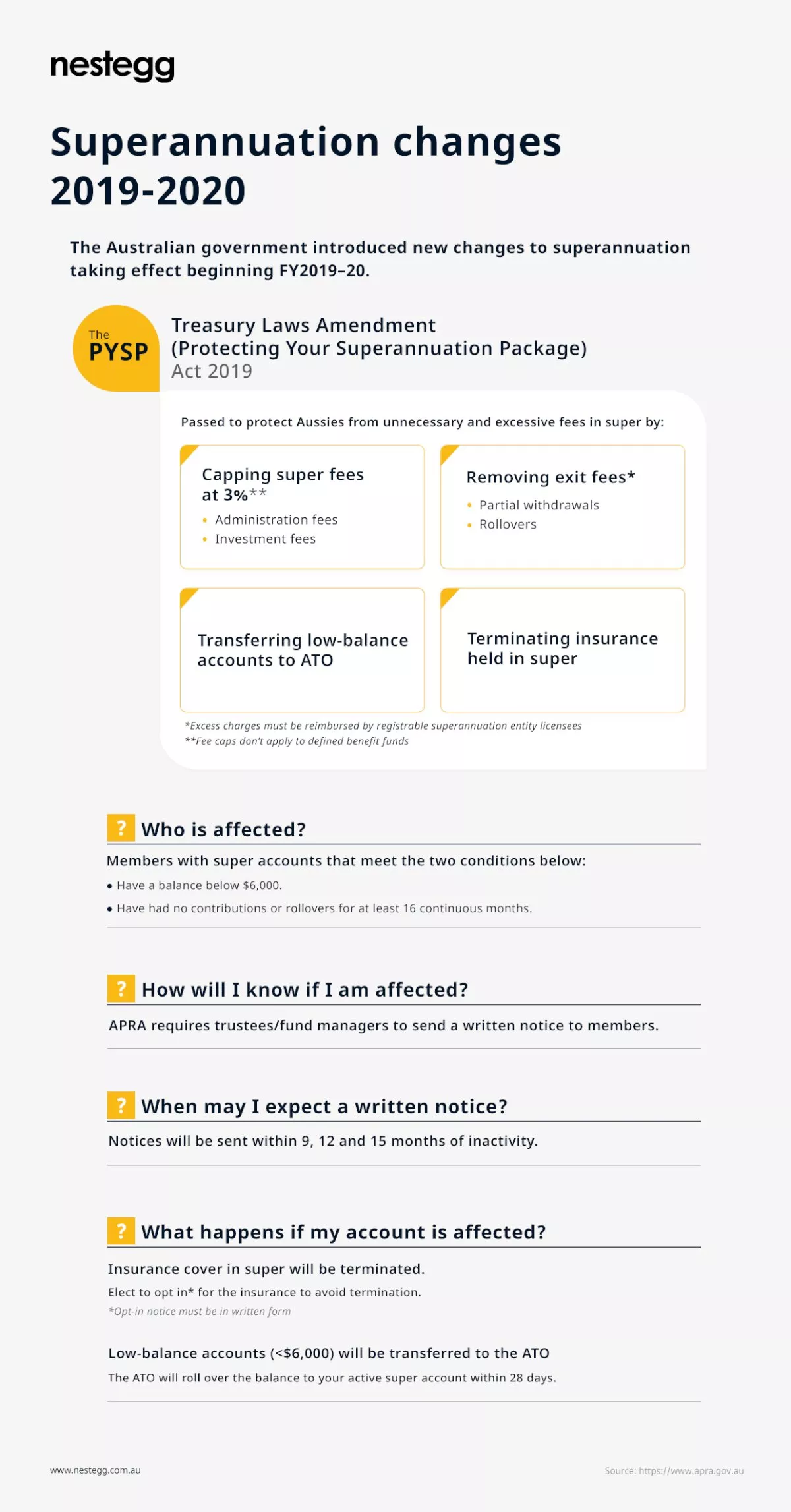Retirement
Superannuation changes 2019-20
To protect low-balance super accounts from unnecessary erosion due to excessive fees and insurance, the Treasury Laws Amendment (Protecting Your Superannuation Package) or PYSP Act 2019 was brought in by the government.
The package of reforms amends the Superannuation Industry (Supervision) Act 1993 (SIS Act), Superannuation (Unclaimed Money and Lost Members) Act 1999 (SUMLM Act) and Taxation Administration Act 1953 (TAA 1953).
Here’s an overview of the changes that are now in effect:
Super accounts with balances below $6,000 that are inactive (meaning they have not received any contributions, rollovers or other transactions for 16 consecutive months) will be terminated. The funds in these accounts will be transferred to the Australian Taxation Office to allow it to consolidate the fund with a member’s active account.
Annual investment and administration fees are now capped at 3 per cent of the account balance. This applies to accounts with balances that are below $6,000.
Super funds are prohibited from charging exit fees. This means that they cannot charge you a fee for consolidating your account or moving a part (or all) of your money to a different fund.
Super accounts with insurance and have been inactive for 16 consecutive months will have their insurance terminated.
With these changes in place, there are steps you must consider to get the best out of your super.
For example, if you have an inactive super account with insurance, you should decide if you want to keep it. Some people may want to keep a low super balance to cover insurance premiums. Other people choose to do so to pay for something they no longer want or they didn’t know they had. If you do want insurance to be included in your super, then you must take proactive steps to not to let it lapse.
It’s also a good time to assess the fees charged by your super fund. You may already have a super provider that is charging you less than 3 per cent in fees and does not impose exit fees. Other super funds may charge you account-based fees, so check if you are paying duplicate fees.
If you have an inactive account and want to maintain it (keep your insurance and/or keep your low-balance super account), there are also steps you must take. You can choose to reactivate your super account by paying money into it or notifying your super fund that you want to opt in to keep your insurance or opt out of consolidating your low-balance super account.
Learn more about the latest super reforms and what they could mean for you. Explore nestegg now!
Superannuation changes 2019-20

To protect low-balance super accounts from unnecessary erosion due to excessive fees and insurance, the Treasury Laws Amendment (Protecting Your Superannuation Package) or PYSP Act 2019 was brought in by the government.
The package of reforms amends the Superannuation Industry (Supervision) Act 1993 (SIS Act), Superannuation (Unclaimed Money and Lost Members) Act 1999 (SUMLM Act) and Taxation Administration Act 1953 (TAA 1953).
Here’s an overview of the changes that are now in effect:
Super accounts with balances below $6,000 that are inactive (meaning they have not received any contributions, rollovers or other transactions for 16 consecutive months) will be terminated. The funds in these accounts will be transferred to the Australian Taxation Office to allow it to consolidate the fund with a member’s active account.
Annual investment and administration fees are now capped at 3 per cent of the account balance. This applies to accounts with balances that are below $6,000.
Super funds are prohibited from charging exit fees. This means that they cannot charge you a fee for consolidating your account or moving a part (or all) of your money to a different fund.
Super accounts with insurance and have been inactive for 16 consecutive months will have their insurance terminated.
With these changes in place, there are steps you must consider to get the best out of your super.
For example, if you have an inactive super account with insurance, you should decide if you want to keep it. Some people may want to keep a low super balance to cover insurance premiums. Other people choose to do so to pay for something they no longer want or they didn’t know they had. If you do want insurance to be included in your super, then you must take proactive steps to not to let it lapse.
It’s also a good time to assess the fees charged by your super fund. You may already have a super provider that is charging you less than 3 per cent in fees and does not impose exit fees. Other super funds may charge you account-based fees, so check if you are paying duplicate fees.
If you have an inactive account and want to maintain it (keep your insurance and/or keep your low-balance super account), there are also steps you must take. You can choose to reactivate your super account by paying money into it or notifying your super fund that you want to opt in to keep your insurance or opt out of consolidating your low-balance super account.
Learn more about the latest super reforms and what they could mean for you. Explore nestegg now!

Superannuation
Rest posts healthy returns following a positive end to 2025
Rest, one of Australia's largest profit-to-member superannuation funds, has reported impressive returns in its flagship MySuper Growth investment option for the year 2025. The fund is optimistic about...Read more

Superannuation
Rest marks milestone with first private equity co-investment exit
In a significant development for Rest, one of Australia’s largest profit-to-member superannuation funds, the organisation has announced the successful completion of its first private equity co-inves...Read more

Superannuation
Expanding super for under-18s could help close the gender super gap, says Rest
In a push to address the gender disparity in superannuation savings, Rest, one of Australia's largest profit-to-member superannuation funds, has called for a significant policy change that would allow...Read more

Superannuation
Employment Hero pioneers real-time super payments with HeroClear integration
In a significant leap forward for Australia's payroll and superannuation systems, Employment Hero, in collaboration with Zepto and OZEDI, has successfully processed the country's first payroll-embedde...Read more

Superannuation
Rest launches Rest Pay to streamline superannuation payments and boost member outcomes
In a significant move aimed at enhancing compliance with upcoming superannuation regulations, Rest, one of Australia’s largest profit-to-member superannuation funds, has unveiled an innovative clear...Read more

Superannuation
Rest appoints experienced governance expert to bolster superannuation fund
Rest, one of Australia's largest profit-to-member superannuation funds, has announced the appointment of Ed Waters as the new Company Secretary. Waters, who brings with him over 15 years of extensive ...Read more

Superannuation
Small businesses brace for cash flow challenges as Payday Super becomes law
With the new Payday Super legislation now enacted, small businesses across Australia are preparing for a significant shift in how they manage superannuation contributions. The law, which mandates a tr...Read more

Superannuation
Rest launches Innovate RAP to support fairer super outcomes for First Nations members
In a significant move towards reconciliation and inclusivity, Rest, one of Australia's largest profit-to-member superannuation funds, has unveiled its Innovate Reconciliation Action Plan (RAP). This i...Read more

Superannuation
Rest posts healthy returns following a positive end to 2025
Rest, one of Australia's largest profit-to-member superannuation funds, has reported impressive returns in its flagship MySuper Growth investment option for the year 2025. The fund is optimistic about...Read more

Superannuation
Rest marks milestone with first private equity co-investment exit
In a significant development for Rest, one of Australia’s largest profit-to-member superannuation funds, the organisation has announced the successful completion of its first private equity co-inves...Read more

Superannuation
Expanding super for under-18s could help close the gender super gap, says Rest
In a push to address the gender disparity in superannuation savings, Rest, one of Australia's largest profit-to-member superannuation funds, has called for a significant policy change that would allow...Read more

Superannuation
Employment Hero pioneers real-time super payments with HeroClear integration
In a significant leap forward for Australia's payroll and superannuation systems, Employment Hero, in collaboration with Zepto and OZEDI, has successfully processed the country's first payroll-embedde...Read more

Superannuation
Rest launches Rest Pay to streamline superannuation payments and boost member outcomes
In a significant move aimed at enhancing compliance with upcoming superannuation regulations, Rest, one of Australia’s largest profit-to-member superannuation funds, has unveiled an innovative clear...Read more

Superannuation
Rest appoints experienced governance expert to bolster superannuation fund
Rest, one of Australia's largest profit-to-member superannuation funds, has announced the appointment of Ed Waters as the new Company Secretary. Waters, who brings with him over 15 years of extensive ...Read more

Superannuation
Small businesses brace for cash flow challenges as Payday Super becomes law
With the new Payday Super legislation now enacted, small businesses across Australia are preparing for a significant shift in how they manage superannuation contributions. The law, which mandates a tr...Read more

Superannuation
Rest launches Innovate RAP to support fairer super outcomes for First Nations members
In a significant move towards reconciliation and inclusivity, Rest, one of Australia's largest profit-to-member superannuation funds, has unveiled its Innovate Reconciliation Action Plan (RAP). This i...Read more








